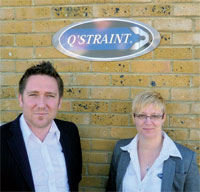
Full Type Approval compliance enhances Q’Straint capability
Q’Straint, the specialist in wheelchair passenger safety based in Kent, has recently enhanced its design and testing capabilities by achieving European Community Whole Vehicle Type Approval (ECWVTA) compliance for accessible vehicles through extensive R&D investment and new in-house expertise.
Q’Straint claims to be the first wheelchair tie-down and occupant restraint (WTORS) specialist to fully comply with both parts of ISO10542 which is required for full ECWVTA compliance. Part 2 of ISO10542 is commonly satisfied by several WTORS suppliers, however Part 1 stipulates that all belt systems and components are subject to rigorous environmental testing in accordance with UN/ ECE Regulation 16. Q’Straint has enhanced it’s procedures to comply with all the multitude of product performance tests required which include mechanical, chemical and temperature-related examinations. This total ECWVTA product conformity is supported by Q’Straint’s continued delivery of occupant restraints which only ever encompass an upper third-point side-wall anchorage above and behind the passenger’s shoulder. A system without upper anchorage such as a floor fixed passenger restraint does not comply with ISO10542 and therefore will not be able to meet ECWVTA.
Many factors such as these have led to Q’Straint launching more of a consultative service for its customers so that potential engineering issues can be eliminated before M1, M2 and M3 accessible vehicles reach ECWVTA examination. Dan Turnbull, Head of Operations for Q’Straint explains: “Here at Q’Straint we understand the concerns associated with Type Approval amongst manufacturers and converters of commercial passenger vehicles. This is why, as an international safety specialist, we are leading the way in providing support through this complex process to ensure hassle is minimised and ultimately Type Approval is consistently achieved for our customers. ECWVTA is a challenge, but by leveraging our close relationship with the VCA and other approval organisations throughout Europe, employing our talented in-house team of technical experts and consulting on overall accessible vehicle conversions while in the design phase, we have already successfully delivered Type Approval to a number of major converters in the UK and throughout Europe. Another industry first is the structured procedure originated by Q’Straint for delivery of reports to approval bodies. Developed by Q’Straint’s Technical Manager Dr Victoria Hodkinson-Gibbs, utilising her vast legislative experience from her time at the Department for Transport and The Highway Agency to produce a concise and accurate scheme for packaging data to the approval body so ECWVTA is achieved effectively and without delay.”
Before accessible vehicles enter ECWVTA examination, Q’Straint now has additional resources to deploy highly experienced UK-based engineers for test days at established facilities such as Millbrook Proving Ground so that design programmes can progress efficiently and positively. Working with an accredited organisation such as Millbrook is essential as no wheelchair passenger solution can be deemed ‘safe’ unless it has been tested independently. This supportive role at test days is an integral part of the new consultative approach that Q’Straint now offers throughout the wider design process involved with a vehicle conversion. This holistic ethos ensures that the Q’Straint WTORS which are already fully ECWVTA compliant, can be installed in equally well conceived vehicles so that passenger safety is maximised.
Dan concludes: “Over and above ECWVTA, the level at which we have tested our components at UTAC and other accredited test centres across Europe over the past 25 years has steadily increased year-on-year to ensure maximum passenger safety. This has led to us becoming first choice for WTORS in many countries across the world and our progressive mission for safety and innovation continues to result in increased global market share. All of our components exceed the basic standards required as there cannot be any margin for compromise in a safety product that ultimately saves lives. In addition to product testing, we believe it is important to give something back to the industry as Q’Straint employs such a unique, diverse range of multinational talent. This has resulted in the deployment of our free design support services and even more advanced testing. Q’Straint continues to raise the bar in terms of industry safety standards and I look forward to assisting many more accessible vehicle converters and manufacturers successfully achieve Type Approval in the coming years.”

